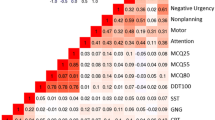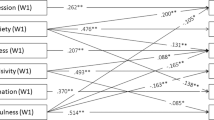Abstract
Sensation seeking and lack of inhibition are often discussed as risk factors for hazardous and maladaptive behavior, particularly during the transition into adulthood. However, some degree and types of novelty-seeking and exploration may also be adaptive and conducive to psychological well-being. The current study examines associations between sensation seeking, impulsivity, and well-being in a large US adult sample (n = 1399, mean age = 36.2 years, range: 18–78). As conceptualized by the UPPS-P model (Whiteside and Lynam, Personality and Individual Differences, 30(4), 669-689, 2001), sensation seeking (pursuit of stimulation) was distinguished from other forms of impulsivity (lack of inhibition) by having a positive association with psychological well-being, eudaimonic well-being, and mental health status. Those positive relations were stronger for younger adults compared to older adults. Negative urgency, lack of perseverance, lack of premeditation, and positive urgency all held either negative or null associations with well-being. Findings indicate that sensation seeking has positive associations with psychological and eudaimonic well-being, in contrast to other elements of impulsivity, and particularly among younger adults.

Similar content being viewed by others
References
Aluja, A., Garcıa, O., & Garcıa, L. F. (2003). Relationships among extraversion, openness to experience, and sensation seeking. Personality and Individual Differences, 35(3), 671–680.
Argyriou, E., Um, M., Carron, C., & Cyders, M. A. (2017). Age and impulsive behavior in drug addiction: a review of past research and future. Pharmacology Biochemistry and Behavior, 164, 106–117.
Arnett, J. J. (2000). Emerging adulthood: a theory of development from the late teens through the twenties. American Psychologist, 55(5), 469.
Blanchflower, D. G., & Oswald, A. J. (2004). Well-being over time in Britain and the USA. Journal of Public Economics, 88(7–8), 1359–1386.
Buhrmester, M., Kwang, T., & Gosling, S. D. (2011). Amazon’s mechanical Turk a new source of inexpensive, yet high-quality, data? Perspectives on Psychological Science, 6(1), 3–5.
Casler, K., Bickel, L., & Hackett, E. (2013). Separate but equal? A comparison of participants and data gathered via Amazon’s MTurk, social media, and face-to-face behavioral testing. Computers in Human Behavior, 29(6), 2156–2160.
Côté, J., & Bynner, J. M. (2008). Changes in the transition to adulthood in the UK and Canada: the role of structure and agency in emerging adulthood. Journal of Youth Studies, 11(3), 251–268.
Cyders, M. A., Littlefield, A. K., Coffey, S., & Karyadi, K. A. (2014). Examination of a short English version of the UPPS-P impulsive behavior scale. Addictive Behaviors, 39, 1372–1376.
Diener, E., Emmons, R. A., Larsen, R. J., & Griffin, S. (1985). The satisfaction with life scale. Journal of Personality Assessment, 49(1), 71–75.
Ellis, B. J., Del Giudice, M., Dishion, T. J., Figueredo, A. J., Gray, P., Griskevicius, V., et al. (2012). The evolutionary basis of risky adolescent behavior: implications for science, policy, and practice. Developmental Psychology, 48(3), 598–623.
Espinoza, J. A., Meyer, J. P., Anderson, B. K., Vaters, C., & Politis, C. (2018). Evidence for a bifactor structure of the scales of psychological well-being using exploratory structural equation modeling. Journal of Well-Being Assessment, 1–20.
Gana, K., Saada, Y., & Amieva, H. (2015). Does positive affect change in old age? Results from a 22-year longitudinal study. Psychology and Aging, 30(1), 172–179.
Harris, K., English, T., Harms, P. D., Gross, J. J., & Jackson, J. J. (2017). Why are extraverts more satisfied? Personality, social experiences, and subjective well-being in college. European Journal of Personality, 31(2), 170–186.
Hill, P. L., & Roberts, B. W. (2012). Narcissism, well-being, and observer-rated personality across the lifespan. Social Psychological and Personality Science, 3(2), 216–223.
Kading, M. L., Hautala, D. S., Palombi, L. C., Aronson, B. D., Smith, R. C., & Walls, M. L. (2015). Flourishing: American Indian positive mental health. Society and Mental Health, 5(3), 203–217.
Keyes, C. L. (2002). The mental health continuum: from languishing to flourishing in life. Journal of Health and Social Behavior, 43, 207–222.
Keyes, C. L. M. (2007). Promoting and protecting mental health as flourishing: a complementary strategy for improving national mental health. American Psychologist, 62, 95–108.
Keyes, C. L. M. (2009). Brief description of the mental health continuum short form (MHC-SF). Available: http://www.sociology.emory.edu/ckeyes/. On–line, June 16, 2018.
Keyes, C. L., Eisenberg, D., Perry, G. S., Dube, S. R., Kroenke, K., & Dhingra, S. S. (2012). The relationship of level of positive mental health with current mental disorders in predicting suicidal behavior and academic impairment in college students. Journal of American College Health, 60(2), 126–133.
Khurana, A., Romer, D., Betancourt, L. M., & Hurt, H. (2018). Modeling trajectories of sensation seeking and impulsivity dimensions from early to late adolescence: universal trends or distinct sub-groups? Journal of Youth and Adolescence, 47(9), 1992–2005.
Lissek, S., Baas, J. M., Pine, D. S., Orme, K., Dvir, S., Rosenberger, E., & Grillon, C. (2005). Sensation seeking and the aversive motivational system. Emotion, 5(4), 396–407.
Lozano, Ó. M., Díaz-Batanero, C., Rojas, A. J., Pilatti, A., & Fernández-Calderón, F. (2018). Concordance between the original and short version of the Impulsive Behaviour Scale UPPS-P using an IRT model. PLoS One, 13(3), e0194390.
Lynam, D. R., Smith G. T., Cyders M. A., Fischer S., Whiteside S. A. (2007). The UPPS-P: A multidimensional measure of risk for impulsive behavior. Unpublished technical report.
Magid, V., MacLean, M. G., & Colder, C. R. (2007). Differentiating between sensation seeking and impulsivity through their mediated relations with alcohol use and problems. Addictive Behaviors, 32(10), 2046–2061.
McKay, S., Skues, J. L., & Williams, B. J. (2018). With risk may come reward: sensation seeking supports resilience through effective coping. Personality and Individual Differences, 121, 100–105.
Nicolaou, N., Shane, S., Cherkas, L., & Spector, T. D. (2008). The influence of sensation seeking in the heritability of entrepreneurship. Strategic Entrepreneurship Journal, 2(1), 7–21.
Paolacci, G., & Chandler, J. (2014). Inside the Turk understanding mechanical Turk as a participant pool. Current Directions in Psychological Science, 23(3), 184–188.
Pavot, W., & Diener, E. (2008). The satisfaction with life scale and the emerging construct of life satisfaction. The Journal of Positive Psychology, 3(2), 137–152.
Peters, J. R., Upton, B. T., & Baer, R. A. (2013). Brief report: relationships between facets of impulsivity and borderline personality features. Journal of Personality Disorders, 27(4), 547–552.
Quinn, P. D., & Harden, K. P. (2013). Differential changes in impulsivity and sensation seeking and the escalation of substance use from adolescence to early adulthood. Development and Psychopathology, 25(1), 223–239.
Quinn, P. D., Stappenbeck, C. A., & Fromme, K. (2011). Collegiate heavy drinking prospectively predicts change in sensation seeking and impulsivity. Journal of Abnormal Psychology, 120(3), 543–566.
Ravert, R. D., Kim, S. Y., Schwartz, S. J., Weisskirch, R. S., Zamboanga, B. L., Ham, L. S., et al. (2013). The association between sensation seeking and well-being among college-attending emerging adults. Journal of College Student Development, 54(1), 17–28.
Roberti, J. W. (2004). A review of behavioral and biological correlates of sensation seeking. Journal of Research in Personality, 38(3), 256–279.
Romer, D., Reyna, V. F., & Satterthwaite, T. D. (2017). Beyond stereotypes of adolescent risk taking: placing the adolescent brain in developmental context. Developmental Cognitive Neuroscience, 27, 19–34.
Ryff, C. D. (1989). Happiness is everything, or is it? Explorations on the meaning of psychological well-being. Journal of Personality and Social Psychology, 57(6), 069–1081.
Ryff, C. D. (2014). Psychological well-being revisited: advances in the science and practice of eudaimonia. Psychotherapy and Psychosomatics, 83(1), 10–28.
Ryff, C. D., & Keyes, C. L. M. (1995). The structure of psychological well-being revisited. Journal of Personality and Social Psychology, 69(4), 719–727.
Schwartz, S. J., Waterman, A. S., Vazsonyi, A. T., Zamboanga, B. L., Whitbourne, S. K., Weisskirch, R. S., Vernon, M., Caraway, S. J., Kim, S. Y., Forthun, L. F., Donnellan, M. B., & Ham, L. S. (2011). The association of well-being with health risk behaviors in college-attending young adults. Applied Developmental Science, 15(1), 20–36.
Sovetkina, E. C. (2014). Exploring the link between sexual behaviour and psychological well-being: the example of university students’ oral sex behaviour. Proceedings of IAC-SSaH 2014, ISBN 978-80-905791-0-1.
Steel, P., Schmidt, J., & Shultz, J. (2008). Refining the relationship between personality and subjective well-being. Psychological Bulletin, 134(1), 138–161.
Sun, J., Kaufman, S. B., & Smillie, L. D. (2017). Unique associations between big five personality aspects and multiple dimensions of well-being. Journal of Personality, 86(2), 158–172.
Waterman, A. S. (2008). Reconsidering happiness: a eudaimonist’s perspective. Journal of Positive Psychology, 3, 234–252.
Waterman, A. S., Schwartz, S. J., Zamboanga, B. L., Ravert, R. D., Williams, M. K., Bede Agocha, V., et al. (2010). The questionnaire for Eudaimonic well-being: psychometric properties, demographic comparisons, and evidence of validity. The Journal of Positive Psychology, 5(1), 41–61.
Whiteside, S. P., & Lynam, D. R. (2001). The five factor model and impulsivity: using a structural model of personality to understand impulsivity. Personality and Individual Differences, 30(4), 669–689.
Wiklund, J., Yu, W., Tucker, R., & Marino, L. D. (2017). ADHD, impulsivity and entrepreneurship. Journal of Business Venturing, 32(6), 627–656.
Yoneda, T., Ames, M. E., & Leadbeater, B. J. (2019). Is there a positive side to sensation seeking? Trajectories of sensation seeking and impulsivity may have unique outcomes in young adulthood. Journal of Adolescence, 73, 42–52.
Zuckerman, M., & Glicksohn, J. (2016). Hans Eysenck’s personality model and the constructs of sensation seeking and impulsivity. Personality and Individual Differences, 103, 48–52.
Acknowledgments
This work was supported by a grant from the University of Missouri Research Council.
Author information
Authors and Affiliations
Corresponding author
Additional information
Publisher’s Note
Springer Nature remains neutral with regard to jurisdictional claims in published maps and institutional affiliations.
Rights and permissions
About this article
Cite this article
Ravert, R.D., Donnellan, M.B. Impulsivity and Sensation Seeking: Differing Associations with Psychological Well-Being. Applied Research Quality Life 16, 1503–1515 (2021). https://doi.org/10.1007/s11482-020-09829-y
Received:
Accepted:
Published:
Issue Date:
DOI: https://doi.org/10.1007/s11482-020-09829-y




